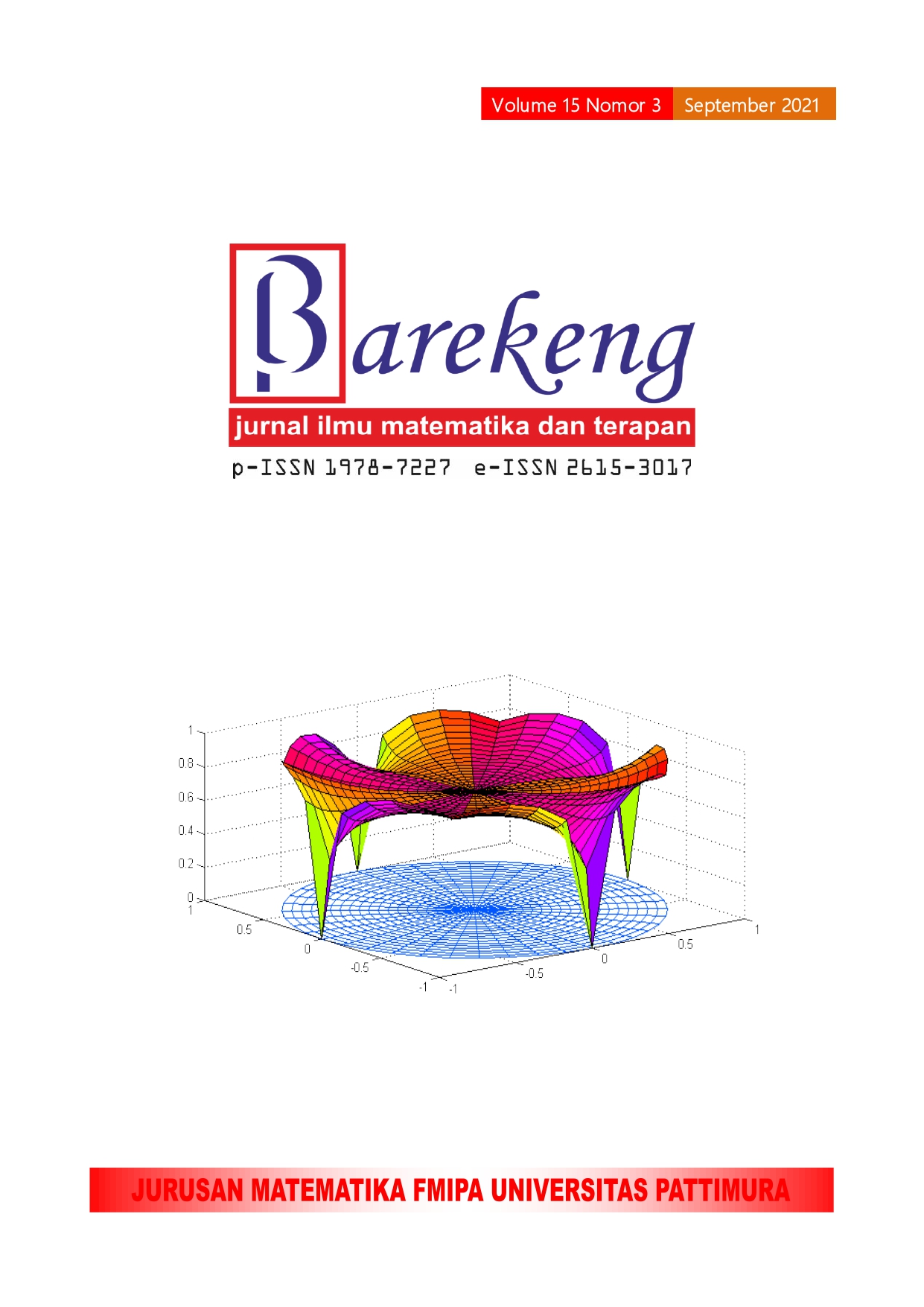MATHEMATICAL MODEL OF DENGUE CONTROL WITH CONTROL OF MOSQUITO LARVAE AND MOSQUITO AFFECTED BY CLIMATE CHANGE
Abstract
Consider a SIR model for the spread of dengue hemorrhagic fever involving three populations, mosquito eggs, mosquitoes, and humans. The parameters of the SIR model were estimated using rainfall data and air temperature for the cities of Pekanbaru and Solok. The main aim of this paper is to determine the effect of mosquito larvae and adult mosquito control on the spread of the dengue virus. Numerical solutions were also presented by using the Runge-Kutta method of order 4. Based on the results, the SIR model was obtained by involving the control parameters of mosquito larvae and adult mosquitoes. Besides, the mosquito population is affected by changes in temperature, rainfall, and fog. Numerical simulations illustrate that the number of infected mosquitoes and infected humans is influenced by the parameters of the percentage of mortality of mosquito larvae and adult mosquitoes.
Downloads
References
Kemenkes, “Demam Berdarah Dengue,†Buletin Jendela Epidemiologi, vol. 2, p. 48, 2010.
M. M. Rossi, L. F. Lopez, and E. Massad, “The Dynamics of Temperature- And Rainfall-Dependent Dengue Transmission in Tropical Regions,†Annals of Biometrics & Biostatistics, vol. 2, no. 2, pp. 1–6, 2015.
A. Sumi, E. F. O. Telan, H. Chagan-Yasutan, M. B. Piolo, T. Hattori, and N. Kobayashi, “Effect of temperature, relative humidity and rainfall on dengue fever and leptospirosis infections in Manila, the Philippines,†Epidemiology and Infection, vol. 145, no. 1, pp. 78–86, 2017, doi: 10.1017/S095026881600203X.
A. K. Supriatna and E. Soewono, “Model Matematika Penyebaran Penyakit Demam Berdarah,†Jurnal Bionatura, vol. 2, no. 3, pp. 1–13, 2000.
S. Side and S. M. Noorani, “A SIR model for spread of dengue fever disease (simulation for South Sulawesi, Indonesia and Selangor, Malaysia),†World Journal of Modelling and Simulation, vol. 9, no. 2, pp. 96–105, 2013.
S. C. Chen and M. H. Hsieh, “Modeling the transmission dynamics of dengue fever: Implications of temperature effects,†Science of the Total Environment, vol. 431, pp. 385–391, 2012, doi: 10.1016/j.scitotenv.2012.05.012.
G. R. Phaijoo and D. B. Gurung, “Modeling Impact of Temperature and Human Movement on the Persistence of Dengue Disease,†Computational and Mathematical Methods in Medicine, vol. 2017, 2017, doi: 10.1155/2017/1747134.
R. Taghikhani and A. B. Gumel, “Mathematics of dengue transmission dynamics: Roles of vector vertical transmission and temperature fluctuations,†Infectious Disease Modelling, vol. 3, pp. 266–292, 2018, doi: 10.1016/j.idm.2018.09.003.
P. S. Murdoch, J. S. Baron, and T. L. Miller, “Potential Effects of Climate Change on Surface †Water,†vol. 36, no. 2, p. 2018, 2018.
P. Chanprasopchai, P. Pongsumpun, and I. M. Tang, “Effect of Rainfall for the Dynamical Transmission Model of the Dengue Disease in Thailand,†Computational and Mathematical Methods in Medicine, vol. 2017, 2017, doi: 10.1155/2017/2541862.
A. Bustamam, D. Aldila, and A. Yuwanda, “Understanding Dengue Control for Short- and Long-Term Intervention with a Mathematical Model Approach,†Journal of Applied Mathematics, vol. 2018, 2018, doi: 10.1155/2018/9674138.
Y. H. Cheng et al., “Assessing health burden risk and control effect on dengue fever infection in the southern region of Taiwan,†Infection and Drug Resistance, vol. 11, pp. 1423–1435, 2018, doi: 10.2147/IDR.S169820.
K. Chudej and A. Fischer, “Optimal Vaccination Strategies for a new Dengue Model with two Serotypes,†IFAC-PapersOnLine, vol. 51, no. 2, pp. 13–18, 2018, doi: 10.1016/j.ifacol.2018.03.003.
L. F. Nie and Y. N. Xue, “The roles of maturation delay and vaccination on the spread of Dengue virus and optimal control,†Advances in Difference Equations, vol. 2017, no. 1, 2017, doi: 10.1186/s13662-017-1323-y.
C. Schreppel and K. Chudej, “Numerical optimal control applied to an epidemiological model,†IFAC-Papers On Line, vol. 51, no. 2, pp. 1–6, 2018, doi: 10.1016/j.ifacol.2018.03.001.
Authors who publish with this Journal agree to the following terms:
- Author retain copyright and grant the journal right of first publication with the work simultaneously licensed under a creative commons attribution license that allow others to share the work within an acknowledgement of the work’s authorship and initial publication of this journal.
- Authors are able to enter into separate, additional contractual arrangement for the non-exclusive distribution of the journal’s published version of the work (e.g. acknowledgement of its initial publication in this journal).
- Authors are permitted and encouraged to post their work online (e.g. in institutional repositories or on their websites) prior to and during the submission process, as it can lead to productive exchanges, as well as earlier and greater citation of published works.






1.gif)



